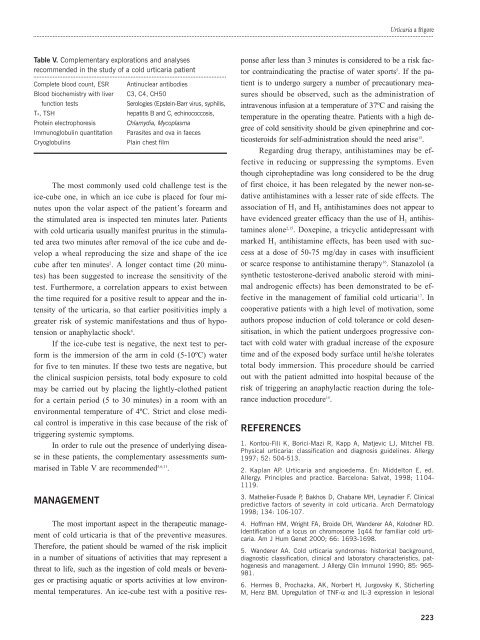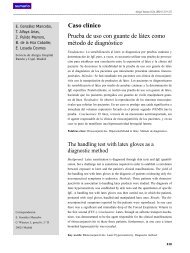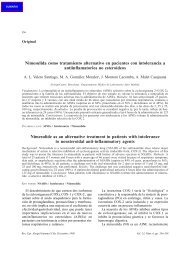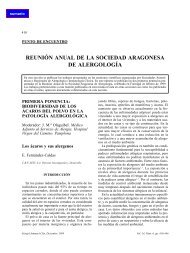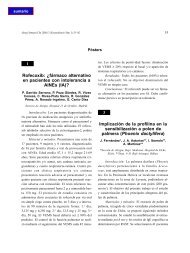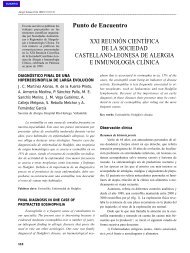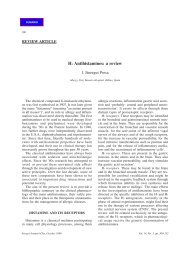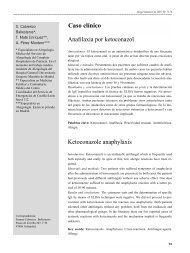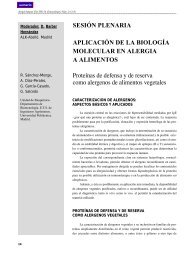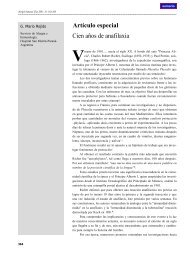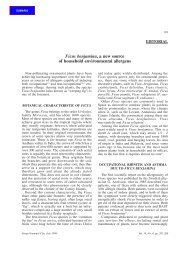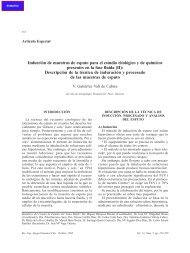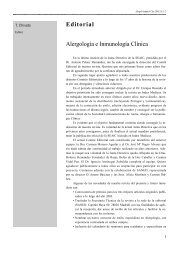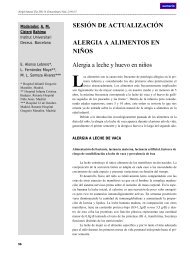a frigore - Alergología e Inmunología Clínica
a frigore - Alergología e Inmunología Clínica
a frigore - Alergología e Inmunología Clínica
Create successful ePaper yourself
Turn your PDF publications into a flip-book with our unique Google optimized e-Paper software.
Table V. Complementary explorations and analyses<br />
recommended in the study of a cold urticaria patient<br />
Complete blood count, ESR Antinuclear antibodies<br />
Blood biochemistry with liver C3, C4, CH50<br />
function tests Serologies (Epstein-Barr virus, syphilis,<br />
T4, TSH hepatitis B and C, echinococcosis,<br />
Protein electrophoresis Chlamydia, Mycoplasma<br />
Immunoglobulin quantitation Parasites and ova in faeces<br />
Cryoglobulins Plain chest film<br />
The most commonly used cold challenge test is the<br />
ice-cube one, in which an ice cube is placed for four minutes<br />
upon the volar aspect of the patient’s forearm and<br />
the stimulated area is inspected ten minutes later. Patients<br />
with cold urticaria usually manifest pruritus in the stimulated<br />
area two minutes after removal of the ice cube and develop<br />
a wheal reproducing the size and shape of the ice<br />
cube after ten minutes 2 . A longer contact time (20 minutes)<br />
has been suggested to increase the sensitivity of the<br />
test. Furthermore, a correlation appears to exist between<br />
the time required for a positive result to appear and the intensity<br />
of the urticaria, so that earlier positivities imply a<br />
greater risk of systemic manifestations and thus of hypotension<br />
or anaphylactic shock 6 .<br />
If the ice-cube test is negative, the next test to perform<br />
is the immersion of the arm in cold (5-10ºC) water<br />
for five to ten minutes. If these two tests are negative, but<br />
the clinical suspicion persists, total body exposure to cold<br />
may be carried out by placing the lightly-clothed patient<br />
for a certain period (5 to 30 minutes) in a room with an<br />
environmental temperature of 4ºC. Strict and close medical<br />
control is imperative in this case because of the risk of<br />
triggering systemic symptoms.<br />
In order to rule out the presence of underlying disease<br />
in these patients, the complementary assessments summarised<br />
in Table V are recommended 5,6,11 .<br />
MANAGEMENT<br />
The most important aspect in the therapeutic management<br />
of cold urticaria is that of the preventive measures.<br />
Therefore, the patient should be warned of the risk implicit<br />
in a number of situations of activities that may represent a<br />
threat to life, such as the ingestion of cold meals or beverages<br />
or practising aquatic or sports activities at low environmental<br />
temperatures. An ice-cube test with a positive res-<br />
Urticaria a <strong>frigore</strong><br />
ponse after less than 3 minutes is considered to be a risk factor<br />
contraindicating the practise of water sports 5 . If the patient<br />
is to undergo surgery a number of precautionary measures<br />
should be observed, such as the administration of<br />
intravenous infusion at a temperature of 37ºC and raising the<br />
temperature in the operating theatre. Patients with a high degree<br />
of cold sensitivity should be given epinephrine and corticosteroids<br />
for self-administration should the need arise 15 .<br />
Regarding drug therapy, antihistamines may be effective<br />
in reducing or suppressing the symptoms. Even<br />
though ciproheptadine was long considered to be the drug<br />
of first choice, it has been relegated by the newer non-sedative<br />
antihistamines with a lesser rate of side effects. The<br />
association of H 1 and H 2 antihistamines does not appear to<br />
have evidenced greater efficacy than the use of H 1 antihistamines<br />
alone 2,15 . Doxepine, a tricyclic antidepressant with<br />
marked H 1 antihistamine effects, has been used with success<br />
at a dose of 50-75 mg/day in cases with insufficient<br />
or scarce response to antihistamine therapy 16 . Stanazolol (a<br />
synthetic testosterone-derived anabolic steroid with minimal<br />
androgenic effects) has been demonstrated to be effective<br />
in the management of familial cold urticaria 17 . In<br />
cooperative patients with a high level of motivation, some<br />
authors propose induction of cold tolerance or cold desensitisation,<br />
in which the patient undergoes progressive contact<br />
with cold water with gradual increase of the exposure<br />
time and of the exposed body surface until he/she tolerates<br />
total body immersion. This procedure should be carried<br />
out with the patient admitted into hospital because of the<br />
risk of triggering an anaphylactic reaction during the tolerance<br />
induction procedure 15 .<br />
REFERENCES<br />
1. Kontou-Fili K, Borici-Mazi R, Kapp A, Matjevic LJ, Mitchel FB.<br />
Physical urticaria: classification and diagnosis guidelines. Allergy<br />
1997; 52: 504-513.<br />
2. Kaplan AP. Urticaria and angioedema. En: Middelton E, ed.<br />
Allergy. Principles and practice. Barcelona: Salvat, 1998; 1104-<br />
1119.<br />
3. Mathelier-Fusade P, Bakhos D, Chabane MH, Leynadier F. Clinical<br />
predictive factors of severity in cold urticaria. Arch Dermatology<br />
1998; 134: 106-107.<br />
4. Hoffman HM, Wright FA, Broide DH, Wanderer AA, Kolodner RD.<br />
Identification of a locus on chromosome 1q44 for familiar cold urticaria.<br />
Am J Hum Genet 2000; 66: 1693-1698.<br />
5. Wanderer AA. Cold urticaria syndromes: historical background,<br />
diagnostic classification, clinical and laboratory characteristics, pathogenesis<br />
and management. J Allergy Clin Immunol 1990; 85: 965-<br />
981.<br />
6. Hermes B, Prochazka, AK, Norbert H, Jurgovsky K, Sticherling<br />
M, Henz BM. Upregulation of TNF-α and IL-3 expression in lesional<br />
223


